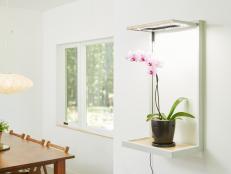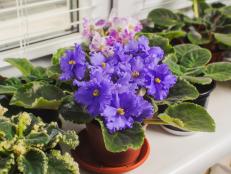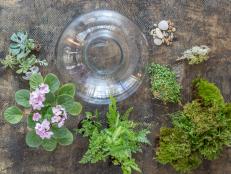Cleaning Indoor Air With Plants

On average, Americans spend 90 percent of their time indoors. Unfortunately, indoor air in today's homes, businesses, and schools is often more polluted than outdoor air. In fact, the Commonwealth Scientific and Industrial Research Organisation estimates that occupants of new homes may be exposed to many times the maximum allowable limits of indoor air pollutants such as formaldehyde and benzene. Exposure to formaldehyde irritates the eyes, nose and throat, can cause headaches and allergic contact dermatitis, and has been linked to asthma. Benzene irritates the eyes and skin.
Indoor air pollution is caused mainly by synthetic building materials, finishes and furnishings that off-gas pollutants. It is also caused by the use of personal-care products, pesticides and household cleaners and by biological sources such as insects, pests, molds and other fungi.
Both builders and homeowners can improve indoor air quality (IAQ). Builders can help by using green building materials instead of materials that contain volatile organic compounds, as many traditionally manufactured carpeting, cabinets, drywalls and paints do. Builders also can design adequate ventilation systems that effectively remove toxins and replace them with fresher air. Homeowners can contribute to improving IAQ by reducing the amount of synthetics and known pollutants they use at home and by opening windows and doors for fresh air as seasonally appropriate. Another important way homeowners can improve IAQ is to add live indoor plants. Certain indoor plants have been proven to help absorb harmful toxins in the air, such as formaldehyde, benzene, trichloroethylene and carbon monoxide.
20 Best Plants for Cleaning Indoor Air 21 Photos
Discover the top 20 air purifying plants that aid in the removal of pollutants.
The National Aeronautics and Space Administration (NASA) and the Associated Landscape Contractors of America (ALCA) conducted research using popular varieties of ornamental plants to determine their effectiveness in removing several key pollutants associated with indoor air pollution. Their findings include the following:
- Indoor plants are capable of removing low levels of pollution from the air through the tiny openings in their leaves.
- Plant roots, assisted by an activated carbon filter and a fan, can remove air pollutants at higher concentrations. The filters around the plant roots remove and biologically degrade pollutants before they accumulate. This is an advantage over advanced-technology carbon filters, which remove pollutants from the air but then require careful disposal.
- Under some conditions, live plants can effectively remove benzene, formaldehyde, carbon monoxide and nitrogen oxides (undesirable products of burning tobacco and wood) from the air.
- Philodendrons, spider plants and golden pothos are the most effective at removing formaldehyde molecules.
- Flowering plants such as gerbera daisies and chrysanthemums are most effective at removing benzene.
- Spider plants placed in closed chambers with 120 parts per million (ppm) of carbon monoxide remove 96 percent of the contaminant in 24 hours. Similarly, spider plants placed in closed chambers with 50 ppm of nitrogen oxide remove 99 percent of it from the air in 24 hours.
According to the NASA/ALCA research, the 10 plants most effective in removing formaldehyde, benzene, trichloroethylene and carbon monoxide from the air are:
- Bamboo palm (Chamaedorea seifrizii)
- Chinese evergreen (Aglaonema modestum)
- English ivy (Hedera helix)
- Gerbera daisy (Gerbera jamesonii)
- Janet Craig (Dracaena fragrans "Janet Craig")
- Marginata (Dracaena marginata)
- Mass cane/corn plant (Dracaena fragrans "Massangeana")
- Mother-in-law's tongue (Sansevieria trifasciata laurentii)
- Pot mum (Chrysanthemum morifolium)
- Peace lily (Spathiphyllum "Mauna Loa")
Careful selection of plant type is necessary if anyone in the household suffers from exposure to molds, pollens, odors or dust. Also, overly damp plant soil may actually promote the growth of unhealthy microorganisms. And while live plants add moisture to the indoor air, which can be beneficial in dry climates, it can be problematic in humid climates, spurring mold growth and higher energy use. Each gallon of water used on indoor plants requires about 3.5 kilowatt-hours (kWh) of electricity to remove, which could increase utility costs
While it's true that plants remove pollutants from the air, plants' ability to control indoor air pollution is less well established. For most indoor air quality problems in the home, source control and adequate ventilation are the most effective solutions.













































